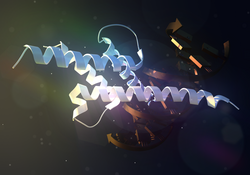
Back CLOCK Catalan CLOCK Esperanto CLOCK Spanish ژن ساعت Persian CLOCK Hungarian CLOCK Singhalese CLOCK Ukrainian 時計遺傳子 ZH-YUE
CLOCK (backronym for circadian locomotor output cycles kaput) is a gene encoding a basic helix-loop-helix-PAS transcription factor that is known to affect both the persistence and period of circadian rhythms.
Research shows that the CLOCK gene plays a major role as an activator of downstream elements in the pathway critical to the generation of circadian rhythms.[5][6]
- ^ a b c GRCh38: Ensembl release 89: ENSG00000134852 – Ensembl, May 2017
- ^ a b c GRCm38: Ensembl release 89: ENSMUSG00000029238 – Ensembl, May 2017
- ^ "Human PubMed Reference:". National Center for Biotechnology Information, U.S. National Library of Medicine.
- ^ "Mouse PubMed Reference:". National Center for Biotechnology Information, U.S. National Library of Medicine.
- ^ Walton ZE, Altman BJ, Brooks RC, Dang CV (4 March 2018). "Circadian Clock's Cancer Connections". Annual Review of Cancer Biology. 2 (1): 133–153. doi:10.1146/annurev-cancerbio-030617-050216. ISSN 2472-3428. S2CID 91120424.
- ^ Dunlap JC (January 1999). "Molecular bases for circadian clocks". Cell. 96 (2): 271–290. doi:10.1016/S0092-8674(00)80566-8. PMID 9988221. S2CID 14991100.





